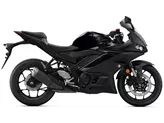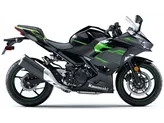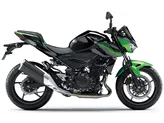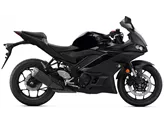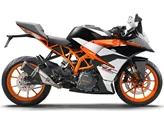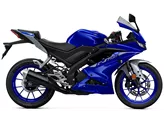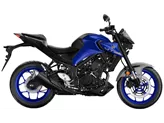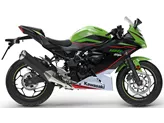Yamaha YZF-R3 2019 vs. Kawasaki Ninja 400 2018

Yamaha YZF-R3 2019

Kawasaki Ninja 400 2018
Pregled - Yamaha YZF-R3 2019 vs Kawasaki Ninja 400 2018
In terms of technical specifications, the Yamaha YZF-R3 2019 has a bore of 68 mm and a stroke of 44.1 mm, while the Kawasaki Ninja 400 2018 has a bore of 70 mm and a stroke of 51.8 mm. The Yamaha YZF-R3 2019 has an engine power of 42 HP and a torque of 29.6 Nm, whereas the Kawasaki Ninja 400 2018 has an engine power of 45 HP and a torque of 38 Nm. Both bikes have a compression ratio of 11.2 and 11.5 respectively.
In terms of engine configuration, both the Yamaha YZF-R3 2019 and the Kawasaki Ninja 400 2018 have 2 cylinders with 4 valves per cylinder. However, the Yamaha YZF-R3 2019 has a displacement of 321 ccm, while the Kawasaki Ninja 400 2018 has a displacement of 399 ccm.
In terms of suspension, the Yamaha YZF-R3 2019 has an upside-down telescopic fork with a diameter of 37 mm for the front suspension, while the Kawasaki Ninja 400 2018 has a telescopic fork with a diameter of 41 mm for the front suspension. Both bikes have a swing arm for the rear suspension.

Yamaha YZF-R3 2019
In terms of chassis, the Yamaha YZF-R3 2019 has a twin tube frame type with a rake of 25 degrees and a trail of 95 mm, while the Kawasaki Ninja 400 2018 has a tubular frame type with a rake of 63 degrees and a trail of 93 mm.
In terms of brakes, both the Yamaha YZF-R3 2019 and the Kawasaki Ninja 400 2018 have a single disk front brake with a diameter of 298 mm and 310 mm respectively.
Both bikes are equipped with ABS as an advanced rider assistance system.

Kawasaki Ninja 400 2018
In terms of dimensions and weights, both the Yamaha YZF-R3 2019 and the Kawasaki Ninja 400 2018 have a front tire width of 110 mm and a front tire diameter of 17 inches. However, the Yamaha YZF-R3 2019 has a rear tire width of 140 mm and a rear tire diameter of 17 inches, while the Kawasaki Ninja 400 2018 has a rear tire width of 150 mm and a rear tire diameter of 17 inches. The Yamaha YZF-R3 2019 has a wheelbase of 1380 mm and a seat height of 780 mm, while the Kawasaki Ninja 400 2018 has a wheelbase of 1370 mm and a seat height of 785 mm. The Yamaha YZF-R3 2019 has a kerb weight (with ABS) of 169 kg and a fuel tank capacity of 14 liters, while the Kawasaki Ninja 400 2018 has a kerb weight (with ABS) of 168 kg and a fuel tank capacity of 14 liters.
In terms of strengths, the Yamaha YZF-R3 2019 has a high-revving engine with sufficient power for everyday use and compact racetracks. It also provides a good basis for racetrack conversions and has stable handling, making it suitable for long distances. On the other hand, the Kawasaki Ninja 400 2018 has a chassis that is suitable for sporty use, with low weight and correspondingly effortless handling. Its engine has smooth response and it offers a relaxed and confidence-enhancing seating position. Additionally, it is equipped with LED headlights.
In terms of weaknesses, the Yamaha YZF-R3 2019 has poor throttle response at low revs and not enough feedback in the brake lever. Some riders may find the knee angle too acute. On the other hand, the Kawasaki Ninja 400 2018 has brake and clutch levers that are not adjustable. Riders over 180cm tall may experience enormously loud wind noise with the original windshield.
Tehnične specifikacije Yamaha YZF-R3 2019 v primerjavi z Kawasaki Ninja 400 2018
Primerjava prednosti in slabosti
Primerjava prednosti in slabosti
Yamaha YZF-R3 2019

Z novim YZF-R3 je Yamaha izkoristila zelo dobro osnovo prve generacije in jo uspešno nadgradila. Zdaj se zdi ne le vizualno zrelejši, temveč tudi opazno bolj kompetenten pri visokih hitrostih. Ko se z modelom R3 peljete na meji, hitro začutite, zakaj je Yamaha nanj postavila svoj pokal, saj že standardni model zagotavlja varen občutek pri visokih hitrostih. Kljub temu je še veliko prostora za izboljšave, zlasti pri vsakodnevni uporabi, ko groba odzivnost pri nizkih vrtljajih in slaba povratna informacija z zavorne ročice povzročita nekaj trenutkov razočaranja med vožnjo.
Kawasaki Ninja 400 2018

Če povzamemo, lahko Ninja 400 označimo kot popoln vstop v svet superšportnikov. Z A2 ne morete dobiti večje moči, videz nakazuje veliko večjo moč, vozilo je igrivo za vožnjo, je v vseh pogledih prizanesljivo in še vedno omogoča resnično športen slog vožnje. Tisti, ki so imeli upravičene pomisleke glede pomanjkanja moči pri različnih 250-kubičnih strojih, zdaj nimajo več izgovorov. Ninja 400, dobro, da te imamo!
Primerjava povprečnih tržnih cen Yamaha YZF-R3 vs Kawasaki Ninja 400
There are a few key differences between a Yamaha YZF-R3 2019 and a Kawasaki Ninja 400 2018. In terms of price, the actual average price of a Kawasaki Ninja 400 2018 is about 9% higher. Compared to Kawasaki Ninja 400 2018 there are less Yamaha YZF-R3 2019 bikes available on the 1000PS.de Marketplace, specifically 4 compared to 10. It takes less time to sell a Yamaha YZF-R3 with 99 days compared to 105 days for a Kawasaki Ninja 400. Since model year 2015 1000PS.de editors have written 11 reviews for the Yamaha YZF-R3 and 9 reviews for the Kawasaki Ninja 400 since model year 2018. The first review for the Yamaha YZF-R3 was published on 10/17/2014 and now has more than 53,600 views. This compares to more than 44,300 views for the first review on Kawasaki Ninja 400 published on 11/22/2017.


